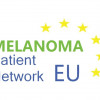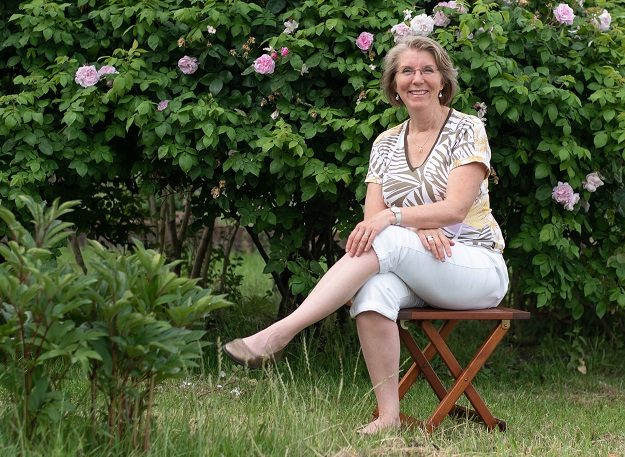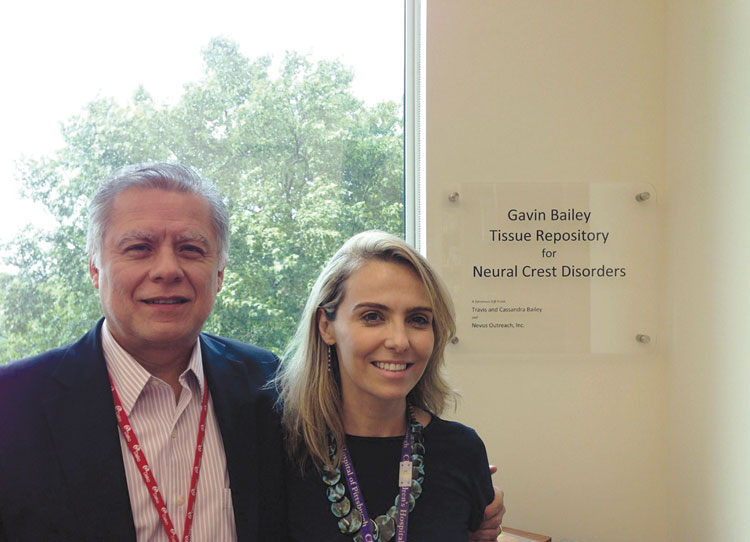
An Interview with Marjolein van Kessel — President of Naevus Global

Thank you, Marjolein, for taking the time to be interviewed! Could you please give us a bit of background about congenital melanocytic naevi and the issues associated with them?
A congenital melanocytic naevus (or CMN) is basically a type of birthmark.
- Congenital = present at birth
- Melanocytic = to do with melanocytes. Melanocytes are cells in everyone’s skin and hair that produce the pigment melanin. This is what gives us our hair and skin colour. The cells in a CMN look most like melanocytes and they produce pigment, so they are called melanocytic.
- Naevus = lesion or mole on the skin (the plural is naevi).
Single small CMN are found in 1% of all newborn babies. Large or very numerous CMN, however, are rare, occurring in around 1 in 20,000 births. The frequency seems to be similar around the world and amongst different populations. CMN can be associated with neurological or brain problems in a minority of people or can be a precondition for development of melanoma in the naevus. For more information: www.naevusinternational.com
Could you tell us something about yourself and your involvement with CMN?
I am the mother of three children but my middle child (son) was born with congenital melanocytic naevus, and also had associated neurological complications. When he was 13 years old he became ill and died of these complications (a condition called neurocutaneous melanocytosis). CMN has an impact on the person with the condition, his siblings, parents, family, and friends. Throughout the life of my son, we dealt with complications of CMN (the last of which were fatal). Because his condition was very rare, we did not always receive good health care. Consequently, I have dedicated myself, as a patient advocate, to improve our knowledge of the disease and the social and healthcare needs associated with it.
What are the latest discoveries or research initiatives in CMN, which you think patients should be aware of?
There are a few interesting research projects in the CMN field at the moment:
1. OCOMEN, Amsterdam UMC/ Erasmus, the Netherlands
The Outcomes for COngenital MElanocytic Naevi (OCOMEN) project is an example. The goal of these projects is to encourage uniformity in reporting research and care in all medical centers specialized in the rare skin disease.
At the moment, different studies looking at CMN often measure different outcomes. For instance, imagine two studies of a new topical treatment for CMN:
Study A - researchers measure the change in colour of CMN
Study B - researchers measure the number of complications after treatment
When the two studies are finished, we cannot compare or combine their results because they have used different outcomes. When a fixed set of outcomes, a so-called core outcome set, is adopted as a standard everywhere, then outcomes will be uniform.
As a consequence, outcomes of research from different medical centres can then be compared or combined. Outcomes that are important for patients will be incorporated in all future research and care settings, since patients will decide, alongside professionals, what the outcomes should be for their own skin disease.
"To improve future care and research of rare skin diseases, it is of great importance that professionals and patients work together"
2. ERN SKIN (Dr. Kinsler, Dr. Vabrès and others)
CMN is caused by cutaneous mosaicism, a term used for a group of disorders in which a person has two or more genetically different populations of cells existing side by side within the skin. It is an area of dermatology in which there has been an explosion of knowledge within the current decade. Mosaicism can be present at birth (congenital) or acquired later in life. Although unsuspected when there are no symptoms, it is also the root cause of many tumors and cancers. Recent discoveries of the genetic basis of many rare mosaic skin disorders has led to fundamental changes in the understanding of the conditions in this field, and to an ongoing shift in the approach to their treatment. More information: ERN SKIN

3. Dr. Heather Etchevers, INSERM, France
Technical progress in human genetics over the last 15 years has made it possible to explore not only hereditary links, but also the specific causes of hundreds of disorders. Many proteins interact both during development and later in life, to help cells divide and proliferate in response to molecular signals from outside the cell. Such signals may arise from neighboring cells or from circulating factors in the blood as relays of information about the body. These can be proteins themselves, but also vitamins, lipids or even gases. Mutations in the genes encoding two proteins known to interact directly inside the cell had been found initially in small, acquired naevi. These develop throughout life in fair-skinned people, often more in response to sun exposure. The same mutations in the same genes had also been identified in malignant melanomas, a lethal cancer of pigment cells. More recently, mosaicism (a condition in which cells within the same person have a different genetic makeup) for a mutation in one or the other of these genes was identified as already present at birth in samples of the largest types of CMN and then in pediatric melanoma and the brain of CMN patients with complications. This last couple of years has witnessed the discovery of many new genes, whose proteins are found to also interact directly or indirectly with the initial two, in different subtypes of CMN and related conditions such as vascular malformations. More information: Research INSERM
4. Gavin Bailey tissue repository (Dr. Miguel Reyes)
Dr. Miguel Reyes, at Pittsburgh Children's Hospital, has made it his life's mission to find a cure for Central Nervous System Melanoma, also known as neurocutaneous melanocytosis (NCM). His team is exclusively dedicated to this and closely collaborates with other physicians around the world who also study this disease. This research project involves building a faithful mouse model to identify novel drug targets and test potential drugs. It will use advanced genome editing techniques, incorporating knowledge from their recent studies on the molecular and genetic characteristics of NCM tumor cells isolated from patient's tumors. Specifically, the newly developed CRISPR-Cas9 method will be used to introduce genetic traits in embryonic mice. Dr. Reyes believes the creation of this mouse model may generate immediately translatable benefits for the affected patients. More information: Gavin Bailey Tissue Repository

5. Global Research on the Impact of Dermatological Diseases (GRIDD) (Global Skin)
GRIDD’s mission is to develop optimized patient-impact outcomes and a new patient-impact measurement tool (questionnaire) by engaging patient organizations and dermatology patients worldwide to produce generic, as well as disease-specific assessments, on the impact of dermatological diseases. The development is based on gathering patients’ views on the impact of their disease on themselves and their caregivers. More information: GRIDD
Thank you so much for giving us your time and informing us about the research in this area. We wish you and your research group all success!
More information: Naevus Global

